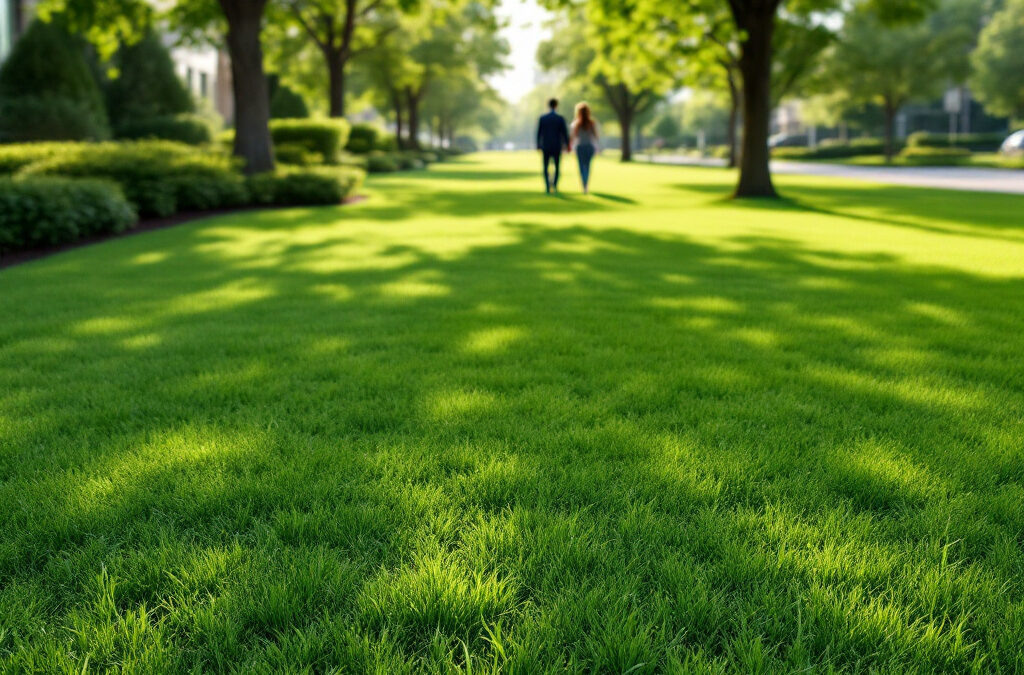Introduction
Maintaining an attractive lawn in office complexes is crucial for enhancing curb appeal, promoting a welcoming environment, and ensuring employee satisfaction. A well-kept lawn can also reduce erosion and improve air quality, making it a vital aspect of commercial landscaping. When selecting grass seed, it’s important to consider various factors such as climate, sunlight, foot traffic, and soil quality to achieve the best results.
1. Understanding the Grass Types
1.1. Cool-Season Grasses
Cool-season grasses thrive in the northern climates, where temperatures are generally moderate. These grasses are known for their lush green appearance and ability to grow vigorously in spring and fall while staying dormant during the hotter summer months. Popular varieties include Kentucky Bluegrass and Perennial Ryegrass, both of which are ideal for office lawns needing a dense and lush coverage.
1.2. Warm-Season Grasses
In contrast, warm-season grasses flourish in southern climates with hot summers. These grasses tend to have a deeper root system, making them drought tolerant and resilient to heat. Varieties like Bermuda Grass and Zoysia Grass are favored for their durability and lower maintenance needs, making them ideal for high-traffic areas in office complexes.
2. Factors Influencing Grass Seed Selection
2.1. Climate and Geography
Before choosing grass seed, it’s crucial to consider the regional climate as it significantly impacts grass growth and maintenance needs. Areas with colder winters may benefit from cool-season grasses which can withstand frost, whereas warmer regions will find success with warm-season varieties. Understanding local climate patterns can guide you towards making the best selection for your office lawn.
Learn more about climate’s impact on landscaping in our article:
How Weather Affects Commercial Concrete Pours.
2.2. Sunlight Availability
Sunlight availability plays a vital role in the growth of grass types. Some grass varieties thrive in full sun, while others are suited for shaded areas. For office complexes with a mix of sun and shade, it’s wise to choose shade-tolerant species such as Fine Fescue to ensure an even and lush lawn throughout the complex.
2.3. Foot Traffic
Considering the level of foot traffic your office complex experiences is essential for selecting durable grass varieties. High-traffic areas require robust grasses that can recover quickly from wear, such as Kentucky Bluegrass or Bermuda Grass. In comparison, low traffic areas could be established with more delicate grass types allowing for a visually appealing, yet less durable lawn.
Need guidance on planning durable outdoor surfaces? Check out
What to Expect During a Commercial Concrete Installation Project.
2.4. Soil Quality
Soil quality is the foundation for a thriving lawn. Conducting soil tests can determine pH levels, nutrient content, and necessary amendments to optimize growth. Understanding the condition of your soil will help you make informed decisions about seed varieties and what amendments are needed to enhance soil health, such as compost or specific fertilizers.
Understanding material characteristics is essential—read more at
How to Choose the Right Concrete Mix for Your Commercial Project.
3. Top Grass Seed Options for Office Complex Lawns
3.1. Best Cool-Season Grasses
Kentucky Bluegrass and Perennial Ryegrass are among the best cool-season grasses suited for office lawns. Kentucky Bluegrass provides a dense, lush look but requires more maintenance, while Perennial Ryegrass germinates quickly and is ideal for overseeding. Both offer a beautiful green space but come with varying maintenance commitments that should be weighed against your needs.
3.2. Best Warm-Season Grasses
For warm-season grasses, Bermuda Grass and Zoysia Grass are highly recommended due to their resilience and low maintenance requirements. Bermuda Grass is excellent for sunny locations and tolerates drought, while Zoysia Grass thrives in partial shade, making it versatile for various office complex layouts. Both varieties will provide a durable sod that can withstand foot traffic and maintain a vibrant appearance.
Ensure your choice is backed by expert preparation—see our
Pre-Pour Checklist for Large Commercial Concrete Jobs.
3.3. Budget-Friendly Options
When it comes to budget-friendly grass seed options, consider blends that combine high-quality seeds at a lower cost. Mixing different types, like Kentucky Bluegrass with Perennial Ryegrass, can provide the best of both worlds: price efficiency and growth diversity. Additionally, buying in bulk can result in significant savings for larger office complexes.
If budgeting is key to your project, find tips in
A Contractor’s Guide to Bidding on Commercial Concrete Jobs Profitably.
4. Grass Seed Buying Tips
4.1. Brand Recommendations
When purchasing grass seed, consider reputable brands known for their high-quality commercial grass seed options. Brands like Scott’s, Barenbrug, and Pennington are recognized for their superior blends and customer satisfaction. Comparing these brands based on quality and price will ensure you’re making an informed choice that meets your budget and lawn health expectations.
4.2. Seed Quality Indicators
Always check the seed packaging for important quality indicators such as germination rates and purity percentages. Higher germination rates lead to quicker, denser lawns. Additionally, look for certifications from organizations like the American Seed Trade Association, as they often ensure that the seeds meet strict quality standards.
4.3. Choosing Between Seed and Sod
When deciding between seed and sod, it’s essential to weigh the pros and cons of each method. Seeding is more cost-effective and allows for a variety of grass types but takes longer to establish. Conversely, sodding provides an instant lawn but can be more expensive. Each method has its best practices, so consider your budget and immediate needs carefully.
Learn the pros and cons by considering similar planning elements from
Differences Between Residential and Commercial Concrete Applications.
5. Care and Maintenance of Office Complex Lawns
5.1. Watering Guidelines
Proper watering is key to maintaining a healthy lawn. Establishing a consistent irrigation schedule based on the type of grass and seasonal weather changes is essential. During hot summer months, grass may require deeper watering less frequently, while cooler seasons may allow for lighter, more frequent watering.
For more maintenance tips with safety in mind, review our article on
Key Safety Measures for Commercial Concrete Pours.
5.2. Mowing Techniques
Mowing practices vary by grass type; generally, keeping grass at a height of 2.5 to 4 inches helps promote strong root growth and discourages weeds. The frequency of mowing can be adjusted based on the growth rate, but a regular schedule is vital to maintain the lawn’s appearance and health.
5.3. Fertilization Strategies
Fertilization plays an important role in lawn maintenance, providing essential nutrients for healthy growth. A recommended schedule involves applying fertilizer in early spring and again in late summer, using formulations appropriate for your grass type. Organic fertilizers can also be beneficial for sustainable lawn care, minimizing chemical use while promoting healthy growth.
Reinforcement and long-term health go hand-in-hand, just like in
The Importance of Reinforcement in Commercial Concrete Work.
Conclusion
Selecting the right grass seed is critical for ensuring the aesthetic and functional success of office lawns. By considering factors such as climate, sunlight, foot traffic, and soil quality, you can make an informed decision that promotes lasting beauty and health. Additionally, following care and maintenance strategies will help maintain a visually appealing lawn that enhances the overall environment of your office complex.
Take the first step toward a greener, more professional property today.


